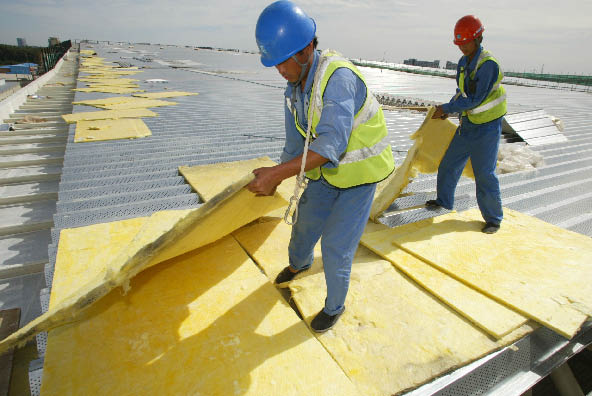| Action on Energy Conservation and
Emission Reduction
The International Energy Agency (IEA) announced in July that China has overtaken the U.S. as the world’s largest energy user. China’s National Energy Bureau immediately challenged the conclusion, citing “inaccurate data.” In fact China has acknowledged pressure from the soaring demand for energy and climate change, and is responding to the issue on all fronts. It is closing down power-greedy plants, developing new energy-saving technologies and products, building energy-smart houses, extending high-speed train service and promoting new-energy automobiles. In 2009 it surpassed the U.S. on investment in clean energies, and public awareness of low-carbon living has taken hold. A 2020 target is in place for slashing its carbon dioxide emissions by 40 or 45 percent per unit of GDP.
Building Energy-frugal Homes
By staff reporter HOU RUILI
 Going retro: many cities are refitting the roofs of local buildings by topping them off with new heat-blocking materials.
Going retro: many cities are refitting the roofs of local buildings by topping them off with new heat-blocking materials.
IN China the total floor space of all commercial and residential buildings tops 43 billion square meters. Only 5 percent of that meets the latest national standard for energy efficiency buildings (the equivalent of 8.75 kilograms of coal for every square meter per heating season). Buildings now consume 27.8 percent of the total amount of China’s energy supply, up from 10 percent in the 1970s, which means 376 million tons of coal are burned every year. This share is expected to climb to one third after 2020, and powering buildings already accounts for 25 percent of greenhouse gases produced by the nation. As early as 10 years ago China began to renovate its energy-rapacious buildings with more environmentally-friendly features, and is picking up the pace. To that end, over the past five years 150 million square meters of homes and offices have been retrofitted.
Goodbye to Coal Stoves
In northern cities like Beijing surviving the long bleak winter eats up a big chunk of annual energy use. When the cold season approaches, families living in the capital city’s hutongs (narrow lanes lined with densely fitted one-story homes) get busy stacking coal cakes. The sheet iron chimneys that protrude from the windows of every hutong home are covered with soot from hundreds or thousands of these dish-sized fuel bricks. Every winter 15 million tons of coal are incinerated in Beijing, disgorging a variety of pollutants that give the sky a perennial grayish tinge.
| 

